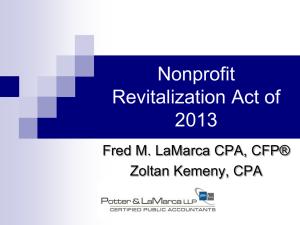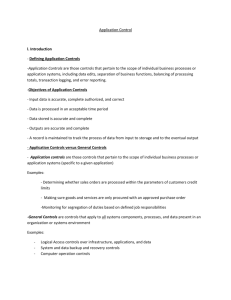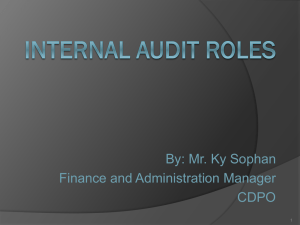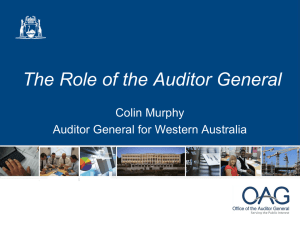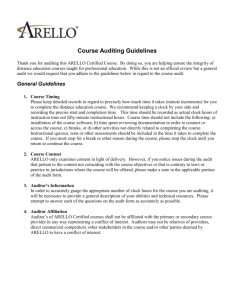KEYS TO A SUCCESSFUL AUDIT - Donna Denker & Associates
advertisement
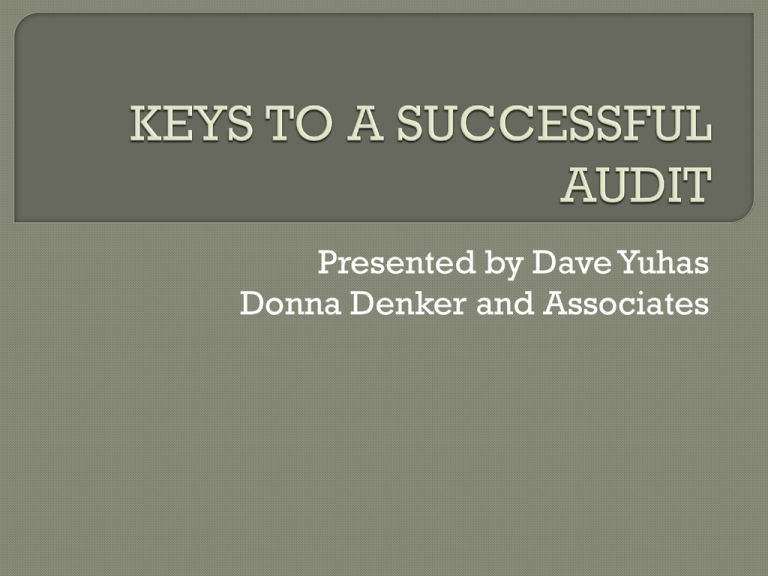
Presented by Dave Yuhas Donna Denker and Associates Please turn off cell phones Questions are mandatory Personal experiences are welcome “Clean” jokes about auditors are acceptable Slow me down if I get going to fast Evaluation • Things you learned • Topics you would like covered at future seminars To gain an understanding of the overall audit process and the steps that can be taken to make your audit successful. Present the audit from another side. Possibly eliminate the fear and instill an assertive approach. What triggers an audit What defines a successful audit The auditor’s report Auditing standards Engagement letter Planning meeting -- entity Minutes Policies/procedures and internal controls Risk assessment Fraud/abuse/asset misappropriation Information/documentation Planning meeting with auditor Litigation/contingencies Account balances and transaction classes Why o’ why do we have to have an audit? • Over $500,000 in Federal expenditures • It’s in the by-laws • By ordinance or resolution • Grant requirement • Funding agency requires • Financial institutions Overall unqualified (clean) opinion No findings No questioned costs What is your definition of a successful audit? • Opinion qualifications expected • Findings not significant or material • Issued before deadline What was audited • Opinion units – could be one or more The standards governing the audit • Generally accepted auditing standards • Governmental auditing standards (yellow book) • Other standards for Single Audits or program specific • Example – Attachment “A” Wording that indicates opinion qualification. Required supplemental information • Budget to Actual • Management Discussion and Analysis Schedule of Expenditures of Federal Awards (SEFA) Going concern Questioned costs Dave – How do you know what you share with us today will result in a “successful” audit? How soon to break? What’s for lunch? Did I forget to shut off my cell phone? There are auditing standards that are mandatory for every kind of audit and the auditor’s work papers must show evidence of compliance with standards. This is what is going to make the difference in your audit…knowing what, why and how. This is what we will focus on today Links to sources – Attachment “B” Read carefully and completely!! Understand your responsibilities Understand • Objective • Procedures the scope of the audit Fee structure When • Well before the auditor shows up Who should be there • Those charged with governance • Management • Program directors • Key accounting personnel The audit preparation guide – Attachment “C” Items to discuss • Contact person • Dates • Attendance and schedules • Prior year audit and findings • Areas of focus • Mental attitudes • Subsequent meetings Auditor may request for period before fiscal year and definitely up until date report is issued. What are they looking for? • Board actions that could or will have financial impact. Contracts/purchase commitments Debt Capital purchases Compensation Discussion on litigations Could include minutes from committees under the governing body. Make sure policies and procedures are current Do they reflect the current process Key controls Auditor is required to gain understanding, document and test Applies to both the financial and compliance areas There will be a report issued Auditor required to perform prior to field work Identification of significant accounts/transaction classes Basis for the type and extent of procedures that auditor will perform Involves selection of samples that will be tested Another area that auditor must address on all engagements and show evidence in work papers. Inquiries at all levels • Governing body • Management • Staff What happens if there is fraud Retribution Confidentiality Always provide copies if possible Inquire about a secure way of sharing Confidentiality Contracts/Grant agreements Loans and leases Minutes Governing documents Communications with funding agencies Personnel policies Refer to audit preparation guide • Attachment “C” Required by standards When • Normally within first few days of field work Who should attend • Management • Members of governing body • Program directors • Key finance staff What will be discussed • General review of fiscal year • Changes Personnel Key accounts PP&E New contracts New benefits Litigation/Contingencies On site visits from funding or regulatory agencies Attorney inquiries • Potential contingencies • Environmental contingencies • Ongoing negotiations with funding agencies What is required to be disclosed • If contingency is probable and outcome can be estimated • Items that will have negative impact on entity Procedures performed will be based on associated risk, significance of account, industry and results of internal control assessment. Auditor required to obtain sufficient evidence to reach conclusion on assertions. Will be tested Adequate controls – a must!! Bank reconciliations are the starting point • Reconciling items • Stale dated checks Confirmations Restrictions Insured Cash and cash equivalents policy Activity between accounts Tends to be a problem area Absence of policies and procedures Good billing/collection process Confirmation • Not effective in most instances • Subsequent receipts Separate by: • • • • Trade Related parties Employees Travel Supporting schedules • Aged • Detailed Collectability • Allowance for doubtful accounts • Collection avenues Investment policy • Provides direction and addresses risks Confirmation Insured Investment activity schedule • Regularly • Deposits and withdrawals • Interest and accrued interest • Realized and unrealized gains/losses Generally not significant account If significant make sure auditor is there for year end inventory Physical inventories • Count sheets • Extended values Policy • Valuation • Expense recognition Definition – Service provided over period of time that is paid up front. Policy for those paid with Federal funds Consistently applied • Types Generally consists of • Insurance • Maintenance contracts Capitalization policy Evidence of physical inventory Federal regulations • What information is required Depreciation schedule • Roll forward • Detailed by category • Allocation by function • Useful lives Reconciliation to general ledger Additions • Support costs to bring into service • Useful life Disposals • Method • Approved • Proceeds Obsolete/impaired Infrastructure Year end cutoff procedures • Date of receipt • Date of invoice • Transfer of title Accounts payable subsidiary report • By vendor • Period of time outstanding Impact on expenditure reports Related party payables • Identify Held checks • Classification Encumbrances • Not the same as payable • Budgeting tool Always should be in balance Confirmation with related parties Should maintain a detailed schedule • By fund • Purpose Disclosures • By fund • Purpose for both Another account where problems tend to show up Liability for goods or service not included in accounts payable. Accrued Wages Prorated Payroll period Taxes and other benefits School contracts Fringe Benefits • FICA – Employer and Employee • Unemployment • Health Expense • Retirement • Vacation or sick time Compensated absences • Detailed schedule Earned Used Extrapolated at current pay rate Current vs. non-current Another account in which balances will be confirmed. Must maintain an activity schedule • Principal payments • Interest payments • New debt Accurate amortization schedules Operating vs. capital leases Covenants • Compliance Generally some form of reconciliation to prior year audited financial statements is first step. Review of general ledger detail There should be no activity that hasn’t been approved by management Prior period adjustments Classifications Budgets are a “must” • Must be created timely to be useful • Must be monitored • Must be a performance measurement • Must be for revenue and expenditures • Must be for all funds General procedures will be comparison of budget to actual followed by inquiry. Presented in financial statements Federal revenues • Schedule of draw downs by fund • Break out accrued/deferred revenue • Program income • Interest income • Pass through funds Donations/Contributions • Maintain a schedule • Identify restrictions Proceeds from sale of assets Insurance reimbursements Settlements Restitution Charges for services • Must have a good billing and collection process • Goes hand in hand with accounts receivable • Auditor will generally perform some form of analytical procedure Will involve testing of internal controls • Support • Authorization • Coding Analytical procedures • Budget to actual • Current year vs. Prior year Significant transaction classes • Salary and wages Reconciliation of general ledger to submitted quarterly reports Highest compensated individuals Bonus/ Incentives Compensation paid as something else Significant transaction classes • Travel • Contract payments • Related parties – note disclosure • Repairs and maintenance • Material transactions Employer (Cont) and employee contributions to retirement plans – disclosure support Manual journal entries • Management overriding controls




